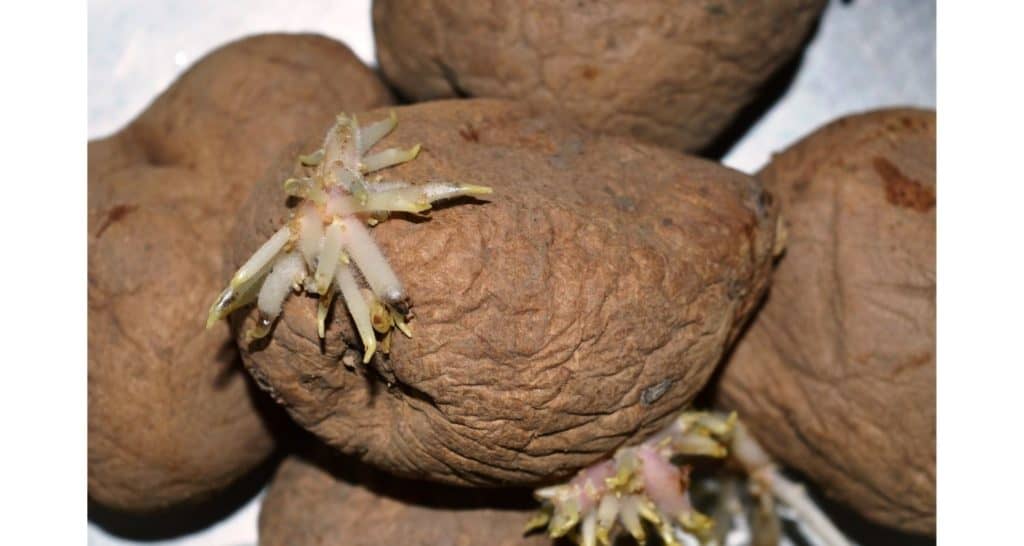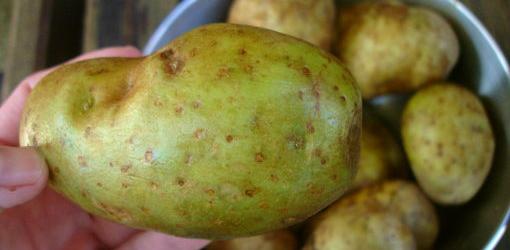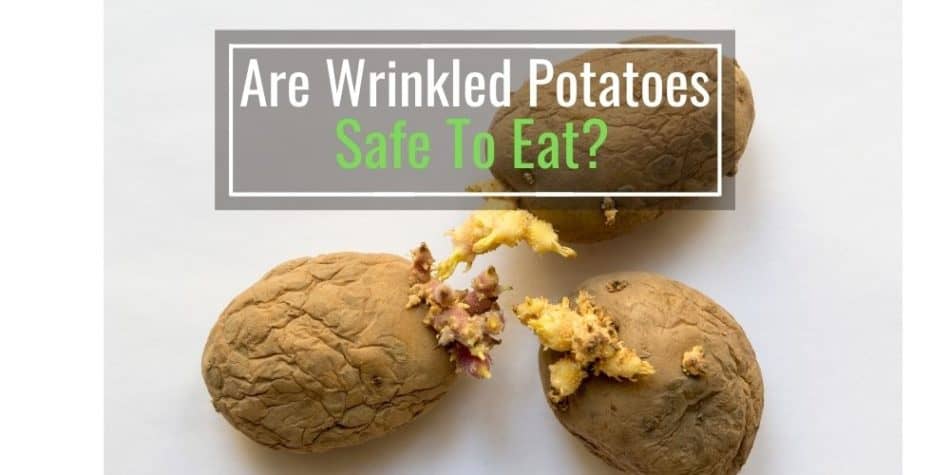Potatoes are a great addition to any meal for that filling starch. So when you open your kitchen cabinet only to be greeted by wrinkled potatoes… what do you do?
Can you still use these wrinkled potatoes? Are wrinkled potatoes safe to eat?
Wrinkled or shriveled potatoes should not be eaten. Wrinkled potatoes, with or without sprouts, have begun their degradation process which means the potato will not be tasty and can cause food poisoning if eaten.
However, potatoes that are still firm to the touch are safe to eat even if there are sprouts or wrinkly spots since these areas can be removed.
Let’s go over some simple tests you can use to determine if your potato is still safe to eat.
Hopefully, this can help prevent a last-minute grocery run.
To help your potatoes last longer, click here to see the best potato storage containers on Amazon.
How To Determine If A Potato Is Still Safe To Eat
First, let’s remember what a fresh potato looks and feels like. Potatoes that are purchased at the store will usually be firm to the touch, have little to no sprouts, and the skin will usually be unblemished.
As the potatoes age, they will become softer, start sprouting, and the potato skin may start developing spots or wrinkles.
So let’s cover a few tests that will help you determine if a potato can be used or if it should be tossed out.
Check The Potato’s Skin Texture
First, check the potato’s skin texture since this can be done by just looking at the potato.
If there is severe wrinkling on the skin and sprouts are shooting out of the potato then do not use this potato for eating. Below is a photo of a bad potato that should not be eaten.

Wrinkled skin with sprouts means the potato is starting to grow into a plant which is great if you want to grow potatoes but bad if you want to eat it.
Potatoes with wrinkled skin will not taste good if eaten and may cause food poisoning. So toss out any potato that has wrinkled skin.
Check The Potato’s Firmness
Next check the potato’s firmness by gently squeezing the potato. If there are lots of soft areas then that is a strong sign that the potato has gone bad.
Toss out any potato that has a lot of soft areas since most of these potatoes are inedible.
Potatoes that are still firm to the touch can be used even if there are sprouts or blemishes on the skin. Use a knife to remove the soft or sprouted areas before eating these potatoes.
Check The Color Of The Skin
Finally check the color of the potato’s skin since older potatoes may turn a green color.
If there are small green spots on the potato then those areas can be removed since the rest of the potato will be edible presuming the potato is still firm.

However, if the entire potato has turned green then toss this potato out. Fully green potatoes can cause food poisoning if consumed so it’s better to play it safe.
Best Way To Store Potatoes
Even though sprouting is a natural process for potatoes, there are a few things that you can do to slow down the process. Properly storing potatoes will help ensure that you have more time to use them before they go bad.
Here are the best conditions for storing potatoes:
- Dark location with little to no sunlight or artificial light
- Cool area that is ideally around 43 – 50°F but cool room temperature is fine
- Dry air to prevent sprouting and mold
Properly storing potatoes in a dark, cool, and dry area will allow them to stay edible for up to 6 months.
Ideally you want to store potatoes by themselves. There are many recommendations about placing all the potatoes in a brown paper bag and placing it in the dark, cool and dry area such as a kitchen cabinet.
There are suggestions that storing potatoes with onions may speed up the sprouting process.
So it’s best to play it safe and store potatoes by themselves in a dark, cool and dry area.
Scientific Reasons Why Wrinkled Potatoes Are Unsafe To Eat
Potatoes are rich in carbohydrates and are a part of a healthy diet and balanced nutrition. If you prepare potatoes right, they are, without a doubt, an excellent source of carbohydrates. And carbohydrates are essential to help to strengthen the body with energy. Still, potatoes can become risky to eat when the strong and smooth skin turns soft and wrinkly.
Potatoes are not only a great source of carbohydrates, but they are also a natural source of solanine and chaconine, which are two types of neurotoxins. Solanine and chaconine are two glycoalkaloid elements commonly present in other kinds of other vegetables and fruits, such as tomatoes and aubergines.
Glycoalkaloids can be toxic to humans, but they may also offer some health benefits that include antibiotic qualities and help control the sugar in your blood. Yet glycoalkaloids, more specifically solanine, can become dangerous to our health if eaten in large quantities.
What are Glycoalkaloids? And Why Are They Dangerous?
Glycoalkaloids are a poisonous substance that can become toxic to humans. Consuming wrinkled potatoes may lead to glycoalkaloid poisoning.
If potatoes have a greenish color on the peeled skin or the potato is wrinkly, this is a clear sign of a high amount of glycoalkaloid content. Another example is the increased presence of solanine content in the sprouted roots that often surfaces on the potatoes.
When potatoes sprout, the natural content of glycoalkaloid found in the potatoes begins to grow and multiply. Because of this, when eating potatoes that have sprouted or are wrinkly, it can cause you to consume large amounts of these toxics.
Effects of Glycoalkaloid
After consuming large quantities of glycoalkaloids, the symptoms usually emerge within a few hours up to 24 hours after eating. You may experience headaches, stomach pains, feeling out of breath, and even vomiting. Some people can also experience diarrhea and hallucinations.
The good news is that most adults and even children experience no symptoms as their system can tolerate it without much of a problem; however, some people are highly susceptible to this toxic.
Studies have also shown that consuming sprouted potatoes can be harmful during pregnancy as the high level of glycoalkaloids can increase the chances of the unborn baby to develop congenital disabilities.
For that reason, pregnant women should not eat sprouted potatoes.
Consuming large amounts of glycoalkaloids can induce low blood pressure, fever, headaches, lack of awareness, and in some cases, it can be fatal.
Studies reveal that eating anything between 30 to 50 mg of glycoalkaloid components per 100 grams of potatoes can lead to glycoalkaloid poison.
Is it possible to remove toxins from sprouted potatoes?
Glycoalkaloids tend to be more present in the potato’s leaves, flowers, and of course, in the sprouts. Yet sometimes, potatoes are containing high quantities of glycoalkaloids without a wrinkly texture.
If the potatoes appear damaged or have a greenish color, and it contains a bitter taste, it can mean that the glycoalkaloid quantity has been increasing massively, and you should avoid consuming.
When boiling and microwaving a potato, there is little evidence that this will decrease or eliminate glycoalkaloid levels. Still, peeling and frying can significantly reduce the presence of glycoalkaloids. However, there is little research on this, so the National Capital Poison Center, also known as Poison Contro, recommends throwing away potatoes that have sprouted, are wrinkly or greenish.
Final Thoughts
Potatoes are a delicious addition to many meals. However, we need to pay attention to how to store them to preserve their quality.
As long as potatoes are stored in a cool, dark, and dry location, then the potatoes will last as long as possible.
Over time, we do need to make sure the potatoes are still safe to eat. Clear signs of bad potatoes are green color, wrinkled skin, and soft texture.
Wrinkled or shriveled potatoes should not be eaten. Wrinkled potatoes, with or without sprouts, have begun their degradation process which means the potato is converting starches into sugars for the plant to grow. This means the potato has lost more of its nutrients, will not be very tasty, and can cause food poisoning if eaten.
However, potatoes that are still firm to the touch are safe to eat even if there are sprouts or wrinkly spots since these areas can be removed.
Just make sure to discard any potentially bad potatoes as the negative health effects of eating a bad potato aren’t worth the risk.

